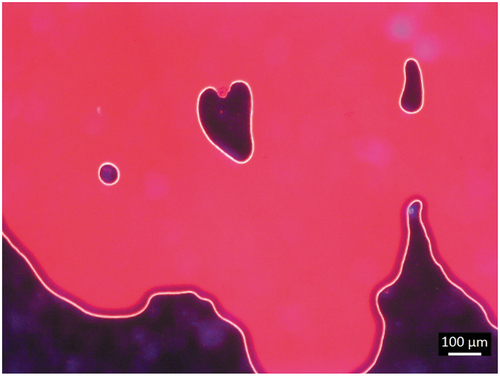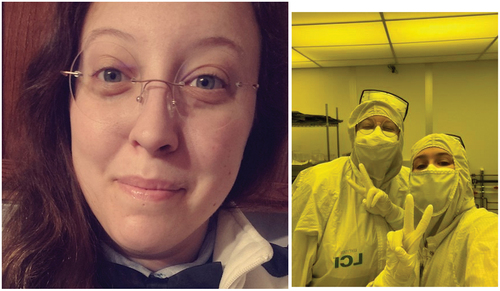 ?Mathematical formulae have been encoded as MathML and are displayed in this HTML version using MathJax in order to improve their display. Uncheck the box to turn MathJax off. This feature requires Javascript. Click on a formula to zoom.
?Mathematical formulae have been encoded as MathML and are displayed in this HTML version using MathJax in order to improve their display. Uncheck the box to turn MathJax off. This feature requires Javascript. Click on a formula to zoom.ABSTRACT
The purpose of this study was to maximise circularly polarised luminescence (CPL) utilising chiral templating that manipulates the helical nature of bent-core liquid crystals (BCLC) concentrated with a high quantum-yield luminophore. Using a chiral template and an achiral phosphorescent and liquid crystal emitter that can allow chirality transfer, the resulting complex induces circular polarisation without aggregation-caused quenching events. This enables the integration of our luminophore into a chiral matrix at very high concentrations. Using this new, all-inclusive model in lab, we designed a polarised light source controlled through the helical-type morphology of the template giving access to a highly tunable CPL system with an excellent dissymmetry factor (). This system can aid in many optical processes or thermal-rate indicators.
Introduction
The Advanced Material and Liquid Crystal Institute at Kent State University served as the canvas for my exploration into the realms of circularly polarised luminescence (CPL). The core of my research focused on optimising CPL by manipulating the helical nature of BCLC combined with a high quantum-yield luminophore called clustomesogen. The clustomesogen is a fascinating hybrid material that combines inorganic metal atom clusters with liquid crystal (LC) molecules. These metal nanoclusters, which are finite groups of metal atoms linked by metal – metal bonds, possess unique phosphorescent properties and are obtained as ternary salt powders. However, their ceramic-like behaviour has limited their use in functional devices. Clustomesogens overcome this limitation by integrating metal nanoclusters into easy-to-process materials. They exploit three main strategies: the covalent approach, the supramolecular approach, and the electrostatic approach. In this study, we focus on the electrostatic approach which permits the combination of the phosphorescence properties of the metal atom cluster with the mobility and fluidity of the LC moieties. These Clustomesogens studied exhibit fascinating LC behaviour, with nematic phases depending on their volumic fraction. Moreover, they can be integrated into electro-controlled devices to tune their photoluminescence or observe polarised emission, opening avenues for exciting applications in photonics, optoelectronics, and lighting. [%] In comparable systems, concentration typically reaches a certain percentage before affecting the quality of the system; however, our study allowed exploration at concentrations an order of magnitude higher. This intricate matrix between chiral templating and our achiral luminophore presented a novel approach, enabling chirality transfer without the pitfalls of aggregation-caused quenching events. The classical approach for the current mechanism for generating CP light is comprised of outside polarisers and rotatable analysers, while our enclosed system contains a luminophore to emit CPL through a BCLC used as host matrix. The result was the induction of circular polarisation at exceptionally high concentrations, a breakthrough with promising applications in optical processes and thermal-rate indicators.
In our investigations, we explored various concentrations () of the luminophore within the BCLC matrix to uncover optimal conditions for maximising glum output and intensity. The process involved polarised optical microscopy (POM) complemented by UV irradiation to ensure solubility and homogeneity within the mixtures. A heating stage allowed us to observe temperature-induced changes, including birefringence under cross-polarisation to monitor the LC phase transitions.
Figure 1. Polarized optical images of varying wt.% concentrations of high quantum yield emitter (clustomesogen, NC). [A:C] under white light revealing birefringence correlating to the template. [B,E] highlighting optimal wt.% concentration under white light and under UV revealing fully homogenous and thorough B4 texture as well as the intense red phosphorescence of the BCLC/Clustomesogen system respectively. Less than optimal wt.% concentration of clustomesogen micrograph under white light [A] and under UV light [D]. Greater than ideal wt.% concentration under white light [C] and under UV [F] showing signs of disruption of the B4 phase.
![Figure 1. Polarized optical images of varying wt.% concentrations of high quantum yield emitter (clustomesogen, NC). [A:C] under white light revealing birefringence correlating to the template. [B,E] highlighting optimal wt.% concentration under white light and under UV revealing fully homogenous and thorough B4 texture as well as the intense red phosphorescence of the BCLC/Clustomesogen system respectively. Less than optimal wt.% concentration of clustomesogen micrograph under white light [A] and under UV light [D]. Greater than ideal wt.% concentration under white light [C] and under UV [F] showing signs of disruption of the B4 phase.](/cms/asset/ca4fb767-65ea-41c8-a0f7-351c63e75480/tlcy_a_2359218_f0001_c.jpg)
One pivotal discovery emerged at a specific weight concentration of the luminophore. This concentration not only exhibited a bright phosphorescence and well-contained response under UV light but also highlighted the typical blue B4 texture of the BCLC under white light when reaching room temperature through fast or slow cooling. The red phosphorescence observed under UV confirmed the complete homogeneity of the mixture. At higher concentrations, however, discontinuities and localised birefringence became apparent, indicating disruption of the BCLC phase and inhomogeneity of the mixture.
Circularly polarised light (CPL) was meticulously captured through the sophisticated CPL Solo instrumentation with subsequent data transformation accomplished using the dissymmetry factor derived from the left-handed polarised light (IL) and right-handed polarised light (IR). This process unfolded across a spectrum of weight concentrations of the clustomesogen dye seamlessly blended within the confines of a bent core liquid crystal (BCLC) mixture.
The focus of this experimentation extended beyond mere data acquisition, with a keen interest in harnessing the potential for sensor applications. The optimal performance was pinpointed within a specific wavelength range corresponding to the peak emission of our luminophore. In this study, the assessment criterion was articulated through the Glum formula, which effectively gauges the luminescence dissymmetry between left-handed and right-handed polarised light.
To gauge the effectiveness of this dissymmetry factor, assessments were conducted at various concentrations of clustomesogen within the BCLC matrix. Notably, optimal synergy within the system emerged at a significantly elevated concentration of the luminophore, suggesting promising avenues for future research and applications with a localized “sweet spot” in clustomesogen weight. However, excess emitter can flood the system and doesn’t mix readily with the BCLC template to polarize incoming light. Additionally, an excess of BCLC results in a loss of intensity as the poorly coated BCLC doesnt efficiently return light when irradiated. Both of these losses can attribute to the same issue, the overall loss of circularly polarized light ().
Figure 2. Multiple Glum concentrations with optimal wt. % concentration highlighted in red transformed via dissymmetry factor [Eqn. 1]. Graph depicted with curve displaying “bell-like” nature, showing the correlation between less/greater than ideal wt. % of emitter in “tails” exuding a loss of CPL.
![Figure 2. Multiple Glum concentrations with optimal wt. % concentration highlighted in red transformed via dissymmetry factor [Eqn. 1]. Graph depicted with curve displaying “bell-like” nature, showing the correlation between less/greater than ideal wt. % of emitter in “tails” exuding a loss of CPL.](/cms/asset/b0252fd3-eb68-4bf7-978e-4ff0d7f84eb2/tlcy_a_2359218_f0002_c.jpg)
The integration of circularly polarised luminescence (CPL) with the innovative combination of chiral templating and luminophore within a BCLC matrix opens new avenues of exploration. The discovery of an optimised concentration, leading to enhanced dissymmetry factors, signifies a breakthrough in our understanding of these materials’ dynamics. This research not only advances our comprehension of BCLC materials but also underscores CPL’s versatility as a tool for diverse applications, including optical processes and sensors, paving the way for further exploration and development in this exciting area of study.
The image ‘Little Love’ is a microphotograph taken under UV light of a Bent Core Liquid Crystal doped with a highly emissive achiral dye called Clustomesogen. The mixture is contained in a Quartz cell with 10 μm spacers and was fast cooled from an isotropic phase. To my surprise, at a 100 μm view through the ocular, I found not only the beautiful red phosphorescence from the Clustomesogen but a little love too! As I continue to make strides in the field of physics, I hope to never stop being curious and get to enjoy all the beautiful intricacies that science continues to allow me to. Thank you for my opportunity to share my story.
About me
At AMLCI, under the supervision of Drs. Marianne Prévôt and Torsten Hegmann, I undertook pioneering research on liquid crystals, culminating in the production of helical light from self-polarising liquid crystals. Before delving into the intricacies of liquid crystals, I forged my path in the industrial landscape as an x-ray qualified pipe welder, managing large-scale projects and leading a team of welders. My precision in welding, characterised by meticulous measurements and efficient project management, found a natural parallel in the analytical demands of experimental physics.
My transition to academia was initiated by an innate curiosity for the unseen forces governing the universe, such as electromagnetic waves and nuclear forces. My unique background as a welder seamlessly translated into my role as an undergraduate researcher at AMLCI. My contributions extend beyond the laboratory, with leadership roles as the President of the Society of Physics Students (SPS) and active participation in mentoring and tutoring roles. Recognised for my academic excellence, I received multiple awards from the Physics Department and Academic Success Center at Kent State University.
Physics is an ”ocean of opportunity,” and my journey from welding to academia is a testament to the interconnectedness of skills. My dedication to research has not only led to groundbreaking discoveries but has also fostered meaningful connections with advisers and peers.
Acknowledgements
The author would like to thank the National Science Foundation NSF (Grant Number: 2050873) for this amazing opportunity as well as Kent State University for hosting the S.U.R.E programme for undergraduate students. Drs. Marianne Prévôt and Torsten Hegmann were wonderful mentors who sought out the excitement within me to curate this project, as well as my lab colleagues who made this undergrad feel more than comfortable and welcomed. Lastly, my husband Brad Thornton, for his consistent support and love while I continue my journey towards my PhD.
Disclosure statement
No potential conflict of interest was reported by the author(s).


